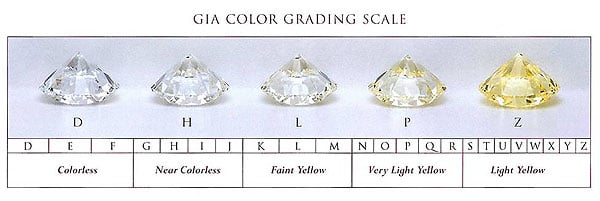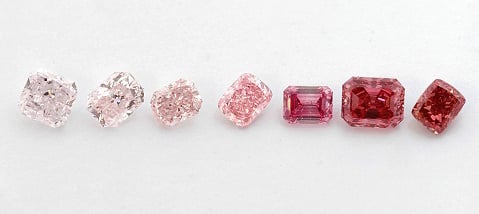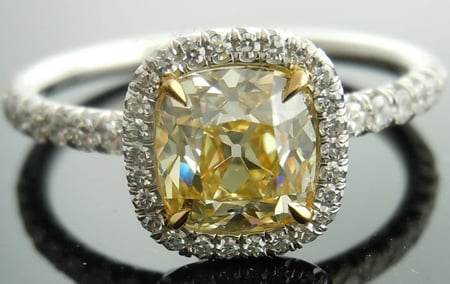Grey and Brown Color?
Diamonds with tints of grey and brown that exhibit more color than the J master stone may be identified as Faint, Very Light, and Light by major grading labs. Brown diamonds with more color than the K master stone are described with a letter grade in addition to a colored diamond grade ranging from Faint to Light Brown. Grey diamonds of K color or greater will be graded Faint, Light, and Very Light without a corresponding letter grade.
Fancy Diamond Color And Price?
Hue, tone, and saturation along with rarity and popularity of color affect fancy colored diamond pricing. Pure red diamonds command the highest prices per carat worldwide. Fine yellow, pink, blue and green diamonds garner high prices depending on quality and size. Brown diamonds are generally the least expensive of natural fancy colors. As with colored stones in general, color is paramount for fancy colored diamond pricing. Other quality factors like clarity and cut do not affect prices as much as with colorless diamonds. All factors equal, higher clarity and more attractive cuts may command higher prices.
It is always recommended to purchase from a trusted vendor, and if you have further questions, a qualified independent appraiser can assist you.
*Stay tuned for fancy colored diamond listings in the Pricescope database. Price comparisons for fancy colored diamonds coming soon.
What Causes Color In Diamonds?
Trace elements, structural irregularities, and radiation generally cause fancy diamond color. Here is a breakdown of common causes of natural fancy diamond color.
Yellow Diamonds – Presence of nitrogen.
Brown, Pink, and Red Diamonds – Colored graining, which results from structural irregularities in the crystal lattice–sometimes in combination with an impurity.
Blue Diamonds – Presence of boron with the possible presence of hydrogen.
Green Diamonds – Natural radiation.
Grey and Violet Diamonds – Most likely the presence of hydrogen (grey diamonds are known for high amounts of hydrogen, while violet diamonds are still being studied for the exact cause of color).
Black Diamonds – Dark inclusions or impurities, which are great in number and evenly distributed throughout a diamond.
Orange Diamonds – Structural irregularities in combination with the presence of trace elements like nitrogen, though the exact cause of color is still being studied.
How Does Diamond Cut Affect Fancy Color?
Unlike their colorless counterparts, fancy colored diamonds are cut to maximize color. Certain shapes will intensify fancy color, and typically, the deeper the pavilion (bottom half of a diamond) the more color is returned to the eye. It is not uncommon to see yellow diamonds fashioned into radiant cuts, as the mixed cut enhances the yellow hue. As with most diamonds, the finished cut is also largely dependent on the shape of the rough and what the cutter can achieve in terms of color grade.
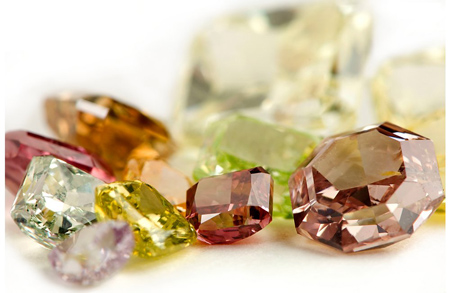
Image courtesy of Blue Nile
The photo (above) shows a variety of fancy colors of different cuts. Fancy colored diamonds are often found in fancy shapes, as certain shapes or cuts are designed to concentrate color.
Does Diamond Fluorescence Affect Fancy Color?
Diamond Fluorescence may enhance a fancy color, but fluorescence often makes no impact on a fancy colored diamond under normal viewing conditions. Yellow diamonds that fluoresce yellow will be more vivid under direct sunlight or uv light, but many yellow diamonds actually fluoresce blue. If you find a fancy colored diamond with complementary fluorescence, it will only intensify or help the color. To learn more please visit our Diamond Fluorescence tutorial.
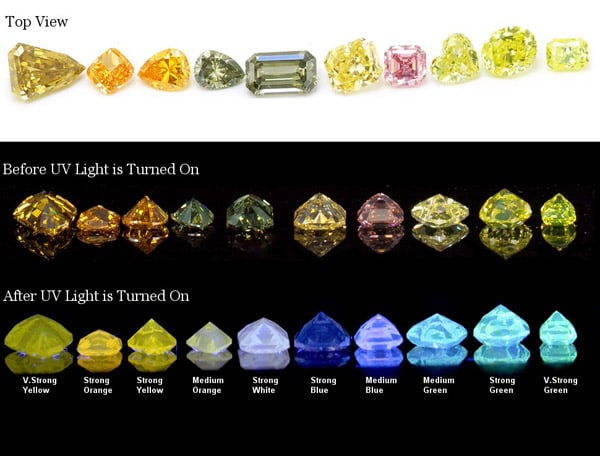
Image Courtesy of Leibish & Co.
GIA color grades for the (above) diamonds
From left to right: Fancy Deep Brownish Yellow, Fancy Vivid Yellow Orange, Fancy Vivid Yellow Orange, Fancy Deep Grayish Yellowish Green/Chameleon, Fancy Dark Gray Yellowish Green/Chameleon, Fancy Intense Yellow, Fancy Pink, Fancy Greenish Yellow, Fancy Intense Green Yellow, Fancy Intense Green Yellow
Where Are Fancy Colored Diamonds Found?
Fancy colored diamonds are found in Australia, Canada, Brazil, and throughout Africa. Pink diamonds are most commonly found at the Argyle mine in Australia, but pink, yellow, blue, and even green diamonds have also been found in the alluvial deposits of Northwest Africa. Visit The Geography of Natural Color Diamonds for more information.
What About Lab Grown Fancy Colored Diamonds?
Synthetic or lab grown diamonds are being produced in a range of colors, and may prove cost effective for those seeking larger sizes of colored diamonds that are appreciably rare. Synthetic diamonds generally have the same chemical composition and crystal structure as natural diamonds. Synthetics should not be confused with simulants, which have different optical and physical characteristics. To learn more about fancy color synthetic diamonds, please visit:
Pricescope Journal Article on Synthetic Diamonds
Laboratory-Grown Diamonds /Man-Made Diamonds (MMD) Discussion Forum

